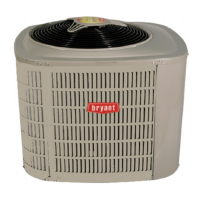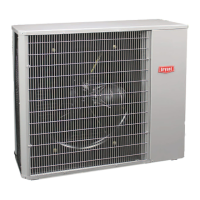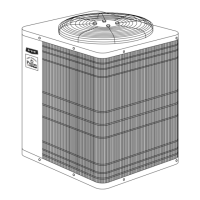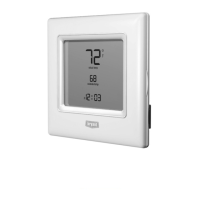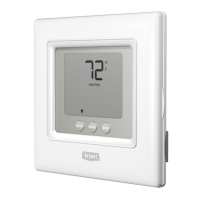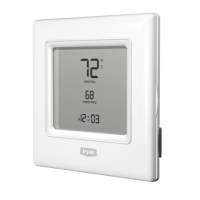24
CONVENIENCE OUTLETS
Two types of convenience outlets are offered on 581J models:
non-powered and unit-powered. Both types provide a 125-v
Ground-Fault Circuit-Interrupter (GFCI) duplex receptacle rated
at 15-A behind a hinged waterproof access cover, located on the
end panel of the unit. See Fig. 26.
Non-Powered Type
This type requires the field installation of a general-purpose 125-v
15-A circuit powered from a source elsewhere in the building. Ob-
serve national and local codes when selecting wire size, fuse or
breaker requirements and disconnect switch size and location.
Route 125-v power supply conductors into the bottom of the utili-
ty box containing the duplex receptacle.
Fig. 26 — Convenience Outlet Location
Unit-Powered Type
A unit-mounted transformer is factory-installed to stepdown the
main power supply voltage to the unit to 115VAC at the duplex re-
ceptacle. This option also includes a manual switch with fuse, lo-
cated in a utility box and mounted on a bracket behind the conve-
nience outlet; access is through the unit’s control box access panel.
See Fig. 26.
Wet in Use Convenience Outlet Cover
The unit has a “wet in use” convenience outlet cover that must be
installed on panel containing the convenience outlet. This cover
provides protection against moisture entering the GFCI receptacle.
This cover is placed in the unit control box during shipment.
Duty Cycle
The unit-powered convenience outlet has a duty cycle limitation.
The transformer is intended to provide power on an intermittent
basis for service tools, lamps, etc. It is not intended to provide
15 amps loading for continuous duty loads (such as electric heat-
ers for overnight use). Observe a 50% limit on circuit loading
above 8 amps (i.e., limit loads exceeding 8 amps to 30 minutes of
operation every hour).
The primary leads to the convenience outlet transformer are not
factory-connected. Selection of primary power source is a custom-
er option. If local codes permit, the transformer primary leads can
be connected at the line-side terminals on a unit-mounted non-
fused disconnect or circuit-breaker switch. This will provide ser-
vice power to the unit when the unit disconnect switch or circuit-
breaker is open. Other connection methods will result in the con-
venience outlet circuit being de-energized when the unit discon-
nect or circuit-breaker is open. See Fig. 27.
Fig. 27 — Powered Convenience Outlet Wiring
GFCI Maintenance
Periodically test the GFCI receptacle by pressing the TEST button
on the face of the receptacle.
1. Press the TEST button on the face of the GFCI receptacle.
This should cause the internal GFCI circuit to trip and
open the receptacle.
2. Inspect for proper grounding and power line phasing
should the GFCI receptacle fail to trip.
WARNING
ELECTRICAL OPERATION HAZARD
Failure to follow this warning could result in personal injury or
death.
Units with convenience outlet circuits may use multiple dis-
connects. Check convenience outlet for power status before
opening unit for service. Locate its disconnect switch, if appro-
priate, and open it. Lock-out and tag-out this switch, if neces-
sary.
Convenience
Outlet
GFCI
Pwd-CO
Fuse
Switch
Pwd-CO
Transformer
Control Box
Access Panel
UNIT
VOLTAGE
CONNECT
AS
PRIMARY
CONNECTIONS
TRANSFORMER
TERMINALS
208, 230 240
L1: RED +YEL
L2: BLU + GRA
H1 + H3
H2 + H4
460 480
L1: RED
Splice BLU + YEL
L2: GRA
H1
H2 + H3
H4
575 600
L1: RED
L2: GRA
H1
H2

